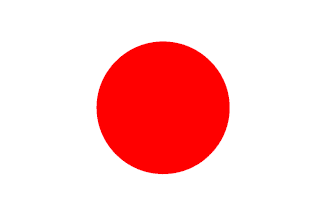 |
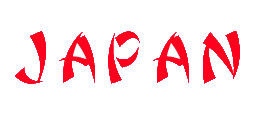 |
PART 2 |
Saturday 18 May 2013
We buy a day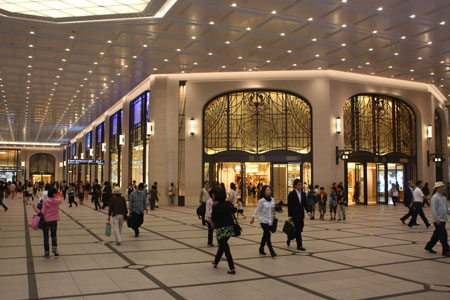 ticket for Osaka's public transport from a vending machine at Nakatsu
station. Aparently we have bought the wrong ticket, because it does not get
us through the ticket gate. In Japan there is always a member of staff
present at the gates. This is no exception and the man helps us out of our
predicament. He disappears behind the machines only to reapear through a
hatch next to the machine's screen. He gives our money back and pushes the
right buttons for the (cheaper) weekend day ticket. We are on our way. First
to Umeda station. We
visit the
Hankyu department store
inside the station. It is a
luxurious affair, owned by the Hankyu railway company. It sells lots of
products. Especially the food department in the basement is impressive.
Everything just looks delicious. We buy a few chocolates. After that we look
for the men's fashion department. I buy polo
shirt by a
ticket for Osaka's public transport from a vending machine at Nakatsu
station. Aparently we have bought the wrong ticket, because it does not get
us through the ticket gate. In Japan there is always a member of staff
present at the gates. This is no exception and the man helps us out of our
predicament. He disappears behind the machines only to reapear through a
hatch next to the machine's screen. He gives our money back and pushes the
right buttons for the (cheaper) weekend day ticket. We are on our way. First
to Umeda station. We
visit the
Hankyu department store
inside the station. It is a
luxurious affair, owned by the Hankyu railway company. It sells lots of
products. Especially the food department in the basement is impressive.
Everything just looks delicious. We buy a few chocolates. After that we look
for the men's fashion department. I buy polo
shirt by a 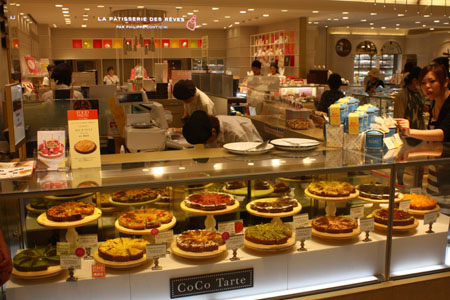 Japanese
designer
Takeo Kikuchi.
Next is a visit to the
HEP Five
shopping centre. There is a
huge Ferris Wheel on its roof. We go for a spin. The view is of the city is
fine. After that we walk to the
Sky Umeda building.
That is a 173 metre high twin tower construction, with a
viewing platform on the 41st floor. The from
there is even better. We
watch out over the river and its many bridges and in the distance we see the
port of Osaka. Down again we have lunch in a small Japanese eatery, after
which we return to the appartment.
Japanese
designer
Takeo Kikuchi.
Next is a visit to the
HEP Five
shopping centre. There is a
huge Ferris Wheel on its roof. We go for a spin. The view is of the city is
fine. After that we walk to the
Sky Umeda building.
That is a 173 metre high twin tower construction, with a
viewing platform on the 41st floor. The from
there is even better. We
watch out over the river and its many bridges and in the distance we see the
port of Osaka. Down again we have lunch in a small Japanese eatery, after
which we return to the appartment.
In the afternoon we go to the
Sumiyoshi Taisha shrine.
The subway station
that we have chosen (Soeminoekoen)
turns out to be a long way from the shrine, as we find
out once we emerge to street level. We
therefore take - also because it is very hot 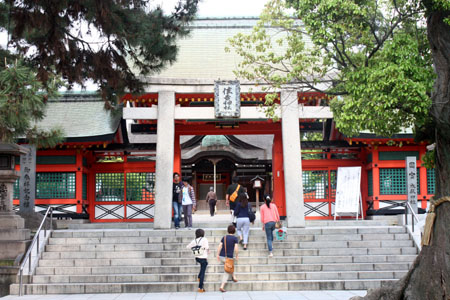 -
a taxi for the last bit of the journey.
This shinto shrine is
the biggest in Osaka and
dates back to 211 AD. We
enter via a nice bow bridge. The are numerous subshrines,
where you can offer your prayers, donate some money and ring the bell to get
some divine attention. We take tram back. A fellow passenger tells us where
to transfer to the subway.
-
a taxi for the last bit of the journey.
This shinto shrine is
the biggest in Osaka and
dates back to 211 AD. We
enter via a nice bow bridge. The are numerous subshrines,
where you can offer your prayers, donate some money and ring the bell to get
some divine attention. We take tram back. A fellow passenger tells us where
to transfer to the subway.
At night we take the subway to Namba,
Osaka's nightlife district. Bright and dynamic light
billboards surround us. We head for the
Dotonbori-canal.
Along the the canal there are boulevards on both sides.
The most famous billboard is the Glico-man,
an advert for a candy brand that has been here for
70 years. It has become an icon
for the city, where people gather to celebrate sport victories (baseball,
soccer). We walk to the restaurant Tsuruntontan.
We do not recognise it at first, because the name is only advertised in
Japanese. It is fairly popular and we have to wait for 30 minutes to get a
table. Fortunately they have a english language menu, which we can study
while we are waiting. Udon is the specialty
here.
It is a thick noodle variety made of wheat. It is served
in a big bowl. Erik takes the curry variety, I the one with tempura prawns.
Tempura stands for battered and deep fried. It is usually done with
vegetables and prawns. Very tasteful. Erik gets a bib around his neck to
protect him against splattering the curry over his shirt. Like most Japanes
restaurants this place has plastic models of all of its dishes in the shop
window, so that you get impression of what your dish is going to look like.
After our delicious meal we get back to Umeda station. From there we walk,
aided by our smartphones gps and a mapping app to Physique,
a small gay bar, located in a
narrow street in the red light district.
Besides that most streets are nameless, Japan's address system is confusing. An address starts with the prefecture (e.g. Nagasaki-ken) and a 7 digit postal code. Except for Tokyo-to, Kyoto-fu and Osaka-fu, which are urban prefectures. Next is the city (shi) or the gun (district) or mura (village). Bigger cities are divided up in ku (ward), followed by chō (district) and chōme (neighbourhood). The neigbourhoods (chōme) are usually numbered: ichi-chōme, ni-chōme, san-chōme etc. At neighbourhood level the housing blocks are numbered. Inside a block each building has a number, but sequentially along the street. They are numbered from the oldest to the newest on the block. The block numbers are usually signosted on lamp posts. The number of the building is usually found near the entrance, but not always. A bar or a restaurant is very often not at the street level (in Japan the 1st floor or 1F), but very often is on a higher floor or underground (B1F or B2F). A billboard in Roman characters and a floor number are something to look for in that case.
For example 6F Koruteire Ginza Bldg, 1-11-5 Shimbashi, Minato Ku, Tokyo-to means the 5th floor of the Koruteire Ginza building in building 5 somewhere on blok 11 in neighbourhood 1 in the Shimbashi distric in the Minato ward in Tokyo. On maps - Google's and Open Street Maps included - blocknumbers are marked.
It seams all very logical, but it can be quite frustrating once you get there. Japanese cannot always figure it out also. If you're stuck ask a postal worker or policeman or you check Google Maps on your smartphone hoping that has marked your particular destination.
Afte a beer and a chat with the owner we say to goodbye to Physique and head back for the appartment.
Weather: sunny, 27°C/80°F.
Zondag 19 mei 2013
Osaka - Fukuoka (Hakata): 622km (367mi) (2:25 hrs by train)
We take the subway to Shin-Osaka, the new railway station on the other
side of the river, where all the high speed Shinkansen-trains 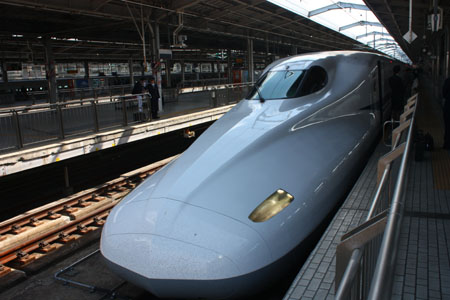 stop.
We show our rail pass to the attendant at the fare gate and we waived
through. Our train will depart from platform 22. We have lots of time to
watch the comings and goings of the Shinkansen. In Japan Shinkansen high
speed trains have been introduced in 1964. At the time they had a top speed
of 220km/h (138mi/h). The present models do up to 300km/h (186mi/h). Trains
come and go all the time and punctual to minute even over long distances.
Frequencies are very high too, even on a Sunday, of up to 6 trains an hour
in every direction. At 9.20 our train, the superexpress called Sakura
(cherry blossom) leaves for Hakata, the eastern station of Fukuoka.
Formerly Hakata and Fukuoka were two separate cities, but now they have
merged into the fourth biggest city of Japan. We are seated comfortably in
our reserved seats. The accelerates quickly to its top speed of 300km/h.
Announcements are both in English and Japanese and the information displays
over the doorways also give travel information in English. Not about delays,
because there are none. The Japanese announcements seem to be much longer
that the English translations. The journey goes through lots of tunnels and
we stop about 6 times before we reach Hakata. After 622km we arrive at
12:04pm at Hakata Station. We take a taxi to
Canal City Washington Hotel.
The room is not ready yet. Check in starts at 2pm. We have some lunch at
Chinese restaurant in the Canal City shopping centre. The dish I have chosen
comes with a much need manual written as a comic strip. The staff watches my
helplessness for a while and comes to my aid to save me from further loss of
face.
stop.
We show our rail pass to the attendant at the fare gate and we waived
through. Our train will depart from platform 22. We have lots of time to
watch the comings and goings of the Shinkansen. In Japan Shinkansen high
speed trains have been introduced in 1964. At the time they had a top speed
of 220km/h (138mi/h). The present models do up to 300km/h (186mi/h). Trains
come and go all the time and punctual to minute even over long distances.
Frequencies are very high too, even on a Sunday, of up to 6 trains an hour
in every direction. At 9.20 our train, the superexpress called Sakura
(cherry blossom) leaves for Hakata, the eastern station of Fukuoka.
Formerly Hakata and Fukuoka were two separate cities, but now they have
merged into the fourth biggest city of Japan. We are seated comfortably in
our reserved seats. The accelerates quickly to its top speed of 300km/h.
Announcements are both in English and Japanese and the information displays
over the doorways also give travel information in English. Not about delays,
because there are none. The Japanese announcements seem to be much longer
that the English translations. The journey goes through lots of tunnels and
we stop about 6 times before we reach Hakata. After 622km we arrive at
12:04pm at Hakata Station. We take a taxi to
Canal City Washington Hotel.
The room is not ready yet. Check in starts at 2pm. We have some lunch at
Chinese restaurant in the Canal City shopping centre. The dish I have chosen
comes with a much need manual written as a comic strip. The staff watches my
helplessness for a while and comes to my aid to save me from further loss of
face.
Later in the afternoon we go for a stroll in the city. We get to Daimaru department store. The history of this chain – once the biggest in Japan – goes back to the early 18th century. On the top floor we find, as in any Japanese department store, a great variety of restaurants. We choose the Italian one. They even give us a knife and fork! Just to be sure the waiter asks us if we want all courses at the same time – Japanese style – or one after the other like it should be the Italian way.
Monday 20 May 2013
Fukuoka - Kumamoto: 118km (73mi), 37 min (train)
Kumamoto - Aso: 50km (31mi) 1:55 min (car)
We have breakfast in the basement of the hotel. It is a buffet and it is
very with busy with Koreans who try to jump the queue. It is a bit noisy.
After breakfast we take bus #8 to the station. There we take Shinkansen
Sakura to Kumamoto. A 37 minute train jou rney.
In Kumamoto a rental car is waiting for us
Nissan-rent-a-car. The attendant speaks very
little English, but we manage to get the car we want. She also explains us
how to use the navigation device that is different from the Toyota one we
had in Kyoto. We get on our way in our Nissan Note. The satnav takes us on a
route following the narrowest of road, which makes us a bit suspicious about
the settings of the device. We still let it lead us the way. The 48km takes
us more than 2 hours, when we reach the Aso caldera. Once we get into the
vulcanic area we see lots of bumps in the landscape. Aso caldera is the
largest crater in the world: 18km from North to South and 24km from East to
West and 120 km around. It was formed some 100,000 years ago when a large
volcano collapsed. Later five new vulcanos popped up, who together are
called Aso-san. Around 70,000 people live now inside the
Caldera. Of the five volcanoes only the Naka-dake is still active. Its last
outburst was in the 1990s. Once at the volcano itself it transpires that the
wind is blowing in the wrong direction and dangerous vapours are preventing
us from visiting the edge. We hang around for a bit, hoping for the wind to
turn. T
rney.
In Kumamoto a rental car is waiting for us
Nissan-rent-a-car. The attendant speaks very
little English, but we manage to get the car we want. She also explains us
how to use the navigation device that is different from the Toyota one we
had in Kyoto. We get on our way in our Nissan Note. The satnav takes us on a
route following the narrowest of road, which makes us a bit suspicious about
the settings of the device. We still let it lead us the way. The 48km takes
us more than 2 hours, when we reach the Aso caldera. Once we get into the
vulcanic area we see lots of bumps in the landscape. Aso caldera is the
largest crater in the world: 18km from North to South and 24km from East to
West and 120 km around. It was formed some 100,000 years ago when a large
volcano collapsed. Later five new vulcanos popped up, who together are
called Aso-san. Around 70,000 people live now inside the
Caldera. Of the five volcanoes only the Naka-dake is still active. Its last
outburst was in the 1990s. Once at the volcano itself it transpires that the
wind is blowing in the wrong direction and dangerous vapours are preventing
us from visiting the edge. We hang around for a bit, hoping for the wind to
turn. T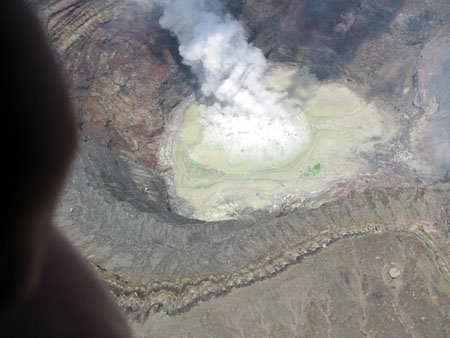 he
tourist complex around the parking lot and the base station of the cable car
is hopelessly out of date and tacky. Un-Japanesely so. We are getting hungry
so we have little choice that to have some lunch here. Just when we want to
drive off, I see that a helicopter is doing tours around the volcano. We
find out where it flies from and decide on the spot do a flight. It costs
¥5000 (€35) per person for four minutes. We have to wait for 15 minutes and
then we are off. The flight is just great. We fly right over the volcano and
can look strait into it. We see boiling lava spitting out gigantic clouds of
smoke. We fly over three times. Spectacular. Back on the get out totally
thrilled.
he
tourist complex around the parking lot and the base station of the cable car
is hopelessly out of date and tacky. Un-Japanesely so. We are getting hungry
so we have little choice that to have some lunch here. Just when we want to
drive off, I see that a helicopter is doing tours around the volcano. We
find out where it flies from and decide on the spot do a flight. It costs
¥5000 (€35) per person for four minutes. We have to wait for 15 minutes and
then we are off. The flight is just great. We fly right over the volcano and
can look strait into it. We see boiling lava spitting out gigantic clouds of
smoke. We fly over three times. Spectacular. Back on the get out totally
thrilled.
Once we have calmed down a bit we drive to Kurakawa.
That is village some two hours driving (only 47km or 29mi) North of Aso. We
go to the resort or Onsen of Yamamizuki.
Here we can take a dip in a natural outdoor thermal pool, a rotemburo. The
area here is dotted with thermal springs, due to the volcanic activity. The
Onsen has separate men and women rotemburos. We undress completely in the
locker room and wash with soap sitting on a tiny stool and rinse with a
shower. When we are completely clean we get outside
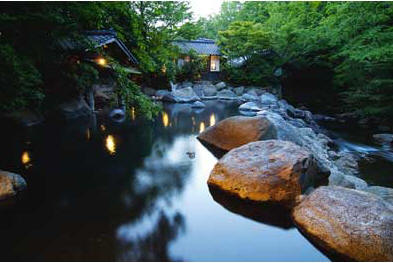 and
step into the hot pool, filled with water from a thermal source. There we
are soaking in a hot water pool in a forest next to fast streaming river.
The pool itself is a little bit landscaped but it a very nice feeling. The
water is warm, very warm. Between 40 and 50 degrees Celsius (104 to 122
Fahrenheit). There only 3 other men in the pool. We stay there for about 40
minutes. Then were are done and we get out to dry ourselves with the tiny
towel that we have rented. We keep sweating, so we do not get completely dry
until we get back into the car and turn the A/C on. We drive back to
Kumamoto. The satnav chooses some very narrow roads through forests, between
rice fields and the tiniest of villages. Just about when had enough of it
has us turn into a bigger road that leads over the top of the mountains in
the direction Kumamoto. The views into the valleys is magnificent. We get
to Kumamoto around 5pm. We return the car at Nissan’s. The mechanic who
inspects it, “talks” to us using a translating app on his smart phone.
Before we board the train we buy a bento-box at the railway
station.
and
step into the hot pool, filled with water from a thermal source. There we
are soaking in a hot water pool in a forest next to fast streaming river.
The pool itself is a little bit landscaped but it a very nice feeling. The
water is warm, very warm. Between 40 and 50 degrees Celsius (104 to 122
Fahrenheit). There only 3 other men in the pool. We stay there for about 40
minutes. Then were are done and we get out to dry ourselves with the tiny
towel that we have rented. We keep sweating, so we do not get completely dry
until we get back into the car and turn the A/C on. We drive back to
Kumamoto. The satnav chooses some very narrow roads through forests, between
rice fields and the tiniest of villages. Just about when had enough of it
has us turn into a bigger road that leads over the top of the mountains in
the direction Kumamoto. The views into the valleys is magnificent. We get
to Kumamoto around 5pm. We return the car at Nissan’s. The mechanic who
inspects it, “talks” to us using a translating app on his smart phone.
Before we board the train we buy a bento-box at the railway
station.
The bento is a lunch box, that Japanese office workers
We are just in time for 5.09pm Sakura superexpress to
Hakata. We have no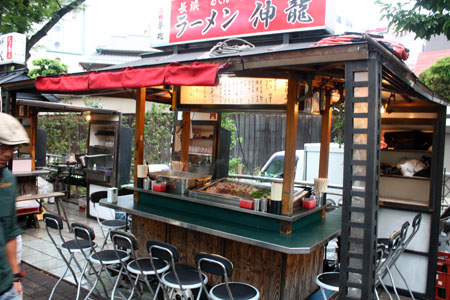 reserved seats this time and we sit in one of the three cars with free
seating at the front of the train. The seats are narrower here (five on a
row), than in the reserved cars, but it is comfortable enough. Back in
Fukuoka we take the bus back to the hotel. Later at night we go for dinner
at one of the food stalls (Yatai) along the river embankment. Yatai are
mobile restaurants, serving noodles and grilled meat on a skewer (yakitori).
It tastes ok, nothing fancy, but the atmosphere is fun. It is not very cheap
either if you – like we did –take lots of meat items.
reserved seats this time and we sit in one of the three cars with free
seating at the front of the train. The seats are narrower here (five on a
row), than in the reserved cars, but it is comfortable enough. Back in
Fukuoka we take the bus back to the hotel. Later at night we go for dinner
at one of the food stalls (Yatai) along the river embankment. Yatai are
mobile restaurants, serving noodles and grilled meat on a skewer (yakitori).
It tastes ok, nothing fancy, but the atmosphere is fun. It is not very cheap
either if you – like we did –take lots of meat items.
Weather: cloudy start, but clear and sunny later. 23 to 25°C (73 to 77°F).
Tuesday 21 May 2013
Fukuoka - Nagasaki: 127km (79mi), 2:07 hrs (Train)
We take
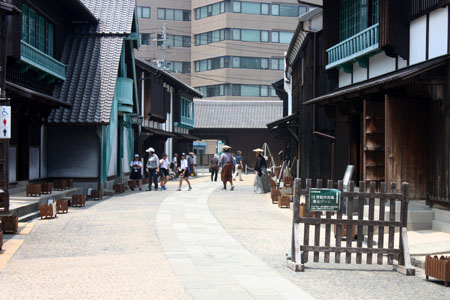 the
bus the station and from there the train to Nagasaki. This
time not a Shinkansen, but a limited express, the Kumome. Somewhat less
comfortable, but it will do just fine. There is on board catering, reclining
seats – nothing else to wish for. Perhaps a bit more speed, as this train
does not do more than 120 km/h (75 mi/h). During the first half of the
journey we stop a lot, but the next hour we follow the coast line at
leisurely pace, more or less uninterrupted. We arrive in Nagasaki at
11.22am. There we buy a day ticket for the tram for ¥500. We take line #1 to
Dejima. On this artificial island the Dutch East Indies company
was authorised in 1609 to set up a trade post to handle the exclusive right
to trade with Japan.
the
bus the station and from there the train to Nagasaki. This
time not a Shinkansen, but a limited express, the Kumome. Somewhat less
comfortable, but it will do just fine. There is on board catering, reclining
seats – nothing else to wish for. Perhaps a bit more speed, as this train
does not do more than 120 km/h (75 mi/h). During the first half of the
journey we stop a lot, but the next hour we follow the coast line at
leisurely pace, more or less uninterrupted. We arrive in Nagasaki at
11.22am. There we buy a day ticket for the tram for ¥500. We take line #1 to
Dejima. On this artificial island the Dutch East Indies company
was authorised in 1609 to set up a trade post to handle the exclusive right
to trade with Japan.
Present Dejima is the result of a reconstruction that started in 1996. It
looks  very
authentic. Inside the buildings volunteers, who speak reasonable English
serve as guides. When say that we are from Holland we are greeted with great
enthusiasm. One of the guides tells us that Japan learned a lot of the Dutch
in the field of technology, science, medicine and philosophy during that
period. He has lived here for 70 years and was witness to the Atom Bomb. He
can remember the mushroom cloud but was not aware at the time what it meant.
His family was spared, but friends died. We have a look at the quarters of
the Head of Mission, the head clerk’s house, a church, the main gate and
many old Dutch documents and objects that were dug up. The rooms are
decorated by meticulously following the examples of pictures that have
remained. TV-screens show animations with (modern) Dutch dialogues. There is
also a model of the ship “De Liefde” (Love), the first Dutch ship to arrive
in Japan in 1600, starting the 400 year relationship. De Nederlanders in
Japan
very
authentic. Inside the buildings volunteers, who speak reasonable English
serve as guides. When say that we are from Holland we are greeted with great
enthusiasm. One of the guides tells us that Japan learned a lot of the Dutch
in the field of technology, science, medicine and philosophy during that
period. He has lived here for 70 years and was witness to the Atom Bomb. He
can remember the mushroom cloud but was not aware at the time what it meant.
His family was spared, but friends died. We have a look at the quarters of
the Head of Mission, the head clerk’s house, a church, the main gate and
many old Dutch documents and objects that were dug up. The rooms are
decorated by meticulously following the examples of pictures that have
remained. TV-screens show animations with (modern) Dutch dialogues. There is
also a model of the ship “De Liefde” (Love), the first Dutch ship to arrive
in Japan in 1600, starting the 400 year relationship. De Nederlanders in
Japan
Het galleon "De Liefde" was one five ship that left Rotterdam in 1598 and was the only one to arrive in Japan in 1600 with a decimated and exhausted crew. The other ships "De Hoop" (hope), "Trouw" (loyalty), "Geloof" (faith) en "De Blijde Boodschap" (gospel) were lost during the journey. The galleon was commanded by the English first officer William Adams and had the Delft
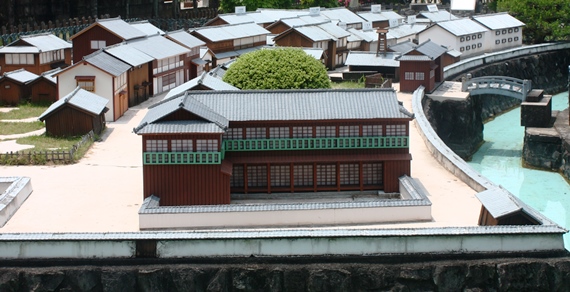 merchant Jan Joosten van Lodensteyn on board. The Shogun had the ship
demolished. The stern of the ship was decorated with a statue of the
Dutch philosopher Erasmus. The statue was rediscovered in 1926 in
Japanese temple where it had been worshipped as local deity for
centuries. In 1609 the Dutch were give a junk to return on to Holland.
Adams and Adams en Jan Joosten stayed behind in Japan. Up till then the
Portugues had been trading with Japan after they had divided the world
between the Spanish and themselves in 1494. With them came missionaries
who started spreading the Christian faith. The Shoguns, the real rulers
of the country felt threatened by that. When the Dutch entered the scene
in 1600, the Portuguese were kicked out. The Dutch had only commercial
motives and that suited the Japanese very well. The Dutch trade monopoly
lasted for about 200 years. Condition for this monopoly was that the
Dutch – the red haired – were restricted to the island of Hirado and
from 1641 to the artificial island of Dejima outside Nagasaki. Once a
year the Head of mission had to travel to Edo (now Tokyo) to report on
the trade. In that period Japan isolated
merchant Jan Joosten van Lodensteyn on board. The Shogun had the ship
demolished. The stern of the ship was decorated with a statue of the
Dutch philosopher Erasmus. The statue was rediscovered in 1926 in
Japanese temple where it had been worshipped as local deity for
centuries. In 1609 the Dutch were give a junk to return on to Holland.
Adams and Adams en Jan Joosten stayed behind in Japan. Up till then the
Portugues had been trading with Japan after they had divided the world
between the Spanish and themselves in 1494. With them came missionaries
who started spreading the Christian faith. The Shoguns, the real rulers
of the country felt threatened by that. When the Dutch entered the scene
in 1600, the Portuguese were kicked out. The Dutch had only commercial
motives and that suited the Japanese very well. The Dutch trade monopoly
lasted for about 200 years. Condition for this monopoly was that the
Dutch – the red haired – were restricted to the island of Hirado and
from 1641 to the artificial island of Dejima outside Nagasaki. Once a
year the Head of mission had to travel to Edo (now Tokyo) to report on
the trade. In that period Japan isolated itself completely and the Dutch were the only contact with the outside
world. Japanese scholars learned Dutch and through Dutch books they
learned about western physics, biology, medicine, shipbuilding and
philosophy. Science in Japan in those days equalled Dutch Science. After
the dissolution of the Dutch East Indies Company in 1799 the trade post
was neglected and disappeared. In 1850 Japan opened up to the world
under American military pressure and the Japanese discovered that not
all foreigners spoke Dutch and the Netherlands were only a small country
in Europe. It was not until 1996 that a reconstruction of Dejima was
started based on old designs and pictures
itself completely and the Dutch were the only contact with the outside
world. Japanese scholars learned Dutch and through Dutch books they
learned about western physics, biology, medicine, shipbuilding and
philosophy. Science in Japan in those days equalled Dutch Science. After
the dissolution of the Dutch East Indies Company in 1799 the trade post
was neglected and disappeared. In 1850 Japan opened up to the world
under American military pressure and the Japanese discovered that not
all foreigners spoke Dutch and the Netherlands were only a small country
in Europe. It was not until 1996 that a reconstruction of Dejima was
started based on old designs and pictures After Dejima we take the tram to Glover Garden. This is situated on a hill with great views of Nagasaki and its bay. On our way to Glover Garden we pass the Ōura-church. This Roman Catholic church is the oldest in Japan and was built in 1864 by French missionaries for the growing expat community in Nagasaki. The Glover Garden is more a villa park for the Western industrial elite that settled here in Japan after 1859. These westerners played a vital role in modernization of the country. In the beginning they were assigned a restricted area to build their homes. These restrictions were lifted in 1899.
Thomas Glover (1838-1911) was a Scott, who came to Japan in 1859 at the age of 22 and set up many
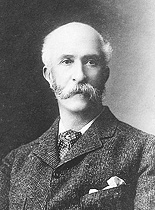 enterprises,
among which a trade in green tea and armaments. In 1860 he supported the
troops of emperor Meiji at overturning the Shogun rule by supplying
arms. The Shoguns, a sort of governors and the real rulers of Japan had
seen themselves forced to concede sovereignty on parts of its territory
to foreign powers like the United States and Great Britain, based on
unequal trade agreements. Emperor Meiji and his supporters wanted to
modernise Japan so that it could withstand foreign pressure. This meant
that the Shoguns had to be pushed aside and the imperial powers
restored. Glover also financed the studies of some of the prominent
rebels abroad, among them Ito Hirobumi, who would later become prime
minister under emperor Meiji’s rule. For his support he received,
shortly before his death in 1910 a high ranking knighthood, the Order of
the Rising Sun. Glover introduced the steam locomotive in Japan, started
t
enterprises,
among which a trade in green tea and armaments. In 1860 he supported the
troops of emperor Meiji at overturning the Shogun rule by supplying
arms. The Shoguns, a sort of governors and the real rulers of Japan had
seen themselves forced to concede sovereignty on parts of its territory
to foreign powers like the United States and Great Britain, based on
unequal trade agreements. Emperor Meiji and his supporters wanted to
modernise Japan so that it could withstand foreign pressure. This meant
that the Shoguns had to be pushed aside and the imperial powers
restored. Glover also financed the studies of some of the prominent
rebels abroad, among them Ito Hirobumi, who would later become prime
minister under emperor Meiji’s rule. For his support he received,
shortly before his death in 1910 a high ranking knighthood, the Order of
the Rising Sun. Glover introduced the steam locomotive in Japan, started
t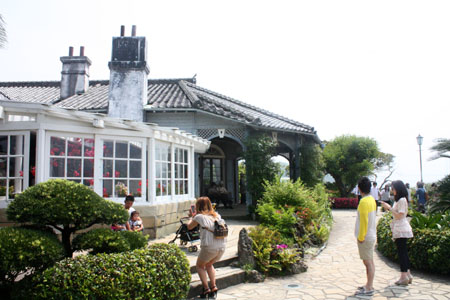 he
first Japanese coalmine, had ships built for the Japanese navy, built
Japans first dry dock and helped founding the Mitsubishi shipyards and
the Kirin beer brewery. Glover had Glover House built with a great view
over the bay. He lived here with his Japanese wife, a former Geisha and
his son Tomisaburo, from an earlier relationship. Tomisaburo became a
popular figure in the Japanese and expat commercial world, but lost his
position and his possessions when Japan went to war in the 1930s,
because – despite his Japanese citizenship – he was seen as a (possible)
western spy. He came under house arrest. He committed suicide after the
atom bomb fell on Nagasaki on 9 August 1945.
he
first Japanese coalmine, had ships built for the Japanese navy, built
Japans first dry dock and helped founding the Mitsubishi shipyards and
the Kirin beer brewery. Glover had Glover House built with a great view
over the bay. He lived here with his Japanese wife, a former Geisha and
his son Tomisaburo, from an earlier relationship. Tomisaburo became a
popular figure in the Japanese and expat commercial world, but lost his
position and his possessions when Japan went to war in the 1930s,
because – despite his Japanese citizenship – he was seen as a (possible)
western spy. He came under house arrest. He committed suicide after the
atom bomb fell on Nagasaki on 9 August 1945. You have to pay entry for the park and escalator take you up hill. The
houses, among the one for the Scottish enterpeneur are open
 to
visitors and were decorated according to old photographs. The view from the
villas on Nagasaki bay is great. Here too, there are many school groups and
cannot escape cooperation to a school project, so that the kids can practice
their English. After Glover garden we take the tram to Chinatown. The trade
realtions with China date back to the middle ages, but took a hiked up again
in the 19th century. Present day Chinatown is not much more than restaurants
and shops. We take the tram to the Kofuku-ji temple.
This is a Zen-Buddhist temple from the 16th century. It is situated at the
edge of a residential area and you do not see it until you are right in
front of it. We take a look round before we take a taxi to the railway
station. We quickly book our seats and take the 4.21pm train back to
Fukuoka. At night we eat at the hotel. I take a Sashimi Gozen set. Erik
is more adventurous and orders a beef hotpot. A gas stove is placed in front
of him and he gets a pot with a beef broth with vegetables that he has to
cook for a while. It tastes quite good.
to
visitors and were decorated according to old photographs. The view from the
villas on Nagasaki bay is great. Here too, there are many school groups and
cannot escape cooperation to a school project, so that the kids can practice
their English. After Glover garden we take the tram to Chinatown. The trade
realtions with China date back to the middle ages, but took a hiked up again
in the 19th century. Present day Chinatown is not much more than restaurants
and shops. We take the tram to the Kofuku-ji temple.
This is a Zen-Buddhist temple from the 16th century. It is situated at the
edge of a residential area and you do not see it until you are right in
front of it. We take a look round before we take a taxi to the railway
station. We quickly book our seats and take the 4.21pm train back to
Fukuoka. At night we eat at the hotel. I take a Sashimi Gozen set. Erik
is more adventurous and orders a beef hotpot. A gas stove is placed in front
of him and he gets a pot with a beef broth with vegetables that he has to
cook for a while. It tastes quite good.
Weather: sunny and humid in Nagasaki. 25°C/77°F
Wednesday 22 May 2013
Fukuoka - Hiroshima: 280km (174mi), 1:09 hrs (train)
Today we take again the Shinkansen Sakura back in the direction of
Shin-Osaka. After little more than an hour we arrive in Hiroshima. We get
into a taxi in front of the station to get to the
Sunroute Hotel Hiroshima.
Of course the room is not ready yet and there we go for coffee at
Starbucks across the street. After coffee we walk to Peace Park, that is
just across the river from the hotel.
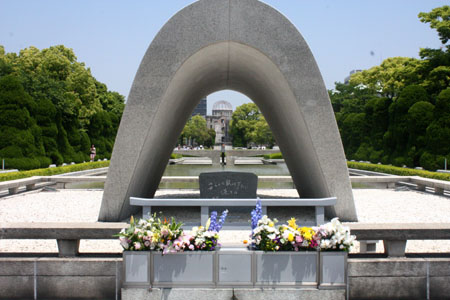 This
is the memorial site for the victims of the first atom bomb, nicknamed
"Little Boy" that exploded here on 6th August 1945 at 8:15am, 580 metres
above the ground after it had been dropped by the American bomber "Enola
Gay". 80,000 people were instantly killed and another 60,000 died within a
year. The total death toll will remain forever unknown. A large part of the
city was devastated. Many of the dead were reduced to dust. After a second
atom bomb on Nagasaki, three days later, Japan finally surrendered on 15th
August 1945, thus ending the Second World War. The
Peace park
is just outside the only remaining ruin Industrial
Promotion Hall from 1914, with its dome now known as the A-bomb dome. We
first visit the central memorial covering a marble coffin holding the names
of all the victims. In a straight line behind it is the eternal flame, that
will burn until the last atomic bomb on earth is destroyed. Behind that is
the children’s memorial. It is devoted to a girl that
suffered from leukemia as result of the explosion. She got the idea that is
she folded 1,000 origami cranes she would be cured. She never made it to
1,000 cranes, because she died
This
is the memorial site for the victims of the first atom bomb, nicknamed
"Little Boy" that exploded here on 6th August 1945 at 8:15am, 580 metres
above the ground after it had been dropped by the American bomber "Enola
Gay". 80,000 people were instantly killed and another 60,000 died within a
year. The total death toll will remain forever unknown. A large part of the
city was devastated. Many of the dead were reduced to dust. After a second
atom bomb on Nagasaki, three days later, Japan finally surrendered on 15th
August 1945, thus ending the Second World War. The
Peace park
is just outside the only remaining ruin Industrial
Promotion Hall from 1914, with its dome now known as the A-bomb dome. We
first visit the central memorial covering a marble coffin holding the names
of all the victims. In a straight line behind it is the eternal flame, that
will burn until the last atomic bomb on earth is destroyed. Behind that is
the children’s memorial. It is devoted to a girl that
suffered from leukemia as result of the explosion. She got the idea that is
she folded 1,000 origami cranes she would be cured. She never made it to
1,000 cranes, because she died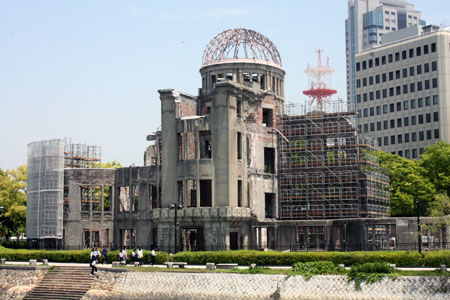 in 1955. He class mates continued her work and these cranes are now on
display in showcases behind the memorial. Countless school groups line up
before it, one after the other singing songs, delivering speeches or
observing a minute of silence. It is impressive to see how the memory of the
atrocities of war are kept alive. We walk back to visit the
Peace Memorial Museum. The
entry fee is only 50 yen (€0.35 or $0.50). Inside the exhibition starts with
an overview of the history of Hiroshima leading up to the bomb. Although the
political radicalization and militarization of Japanese politics in the
1930s is mentioned, the exhibition is very brief about Japan’s share in the
war’s atrocities. For instance the Nanking massacre is only referred to in
passing as the “Nanking Incident”, without getting into detail about the
unprecedented raping, killing and pillaging that Japanese soldiers committed
there. Upstairs the exhibitions
in 1955. He class mates continued her work and these cranes are now on
display in showcases behind the memorial. Countless school groups line up
before it, one after the other singing songs, delivering speeches or
observing a minute of silence. It is impressive to see how the memory of the
atrocities of war are kept alive. We walk back to visit the
Peace Memorial Museum. The
entry fee is only 50 yen (€0.35 or $0.50). Inside the exhibition starts with
an overview of the history of Hiroshima leading up to the bomb. Although the
political radicalization and militarization of Japanese politics in the
1930s is mentioned, the exhibition is very brief about Japan’s share in the
war’s atrocities. For instance the Nanking massacre is only referred to in
passing as the “Nanking Incident”, without getting into detail about the
unprecedented raping, killing and pillaging that Japanese soldiers committed
there. Upstairs the exhibitions 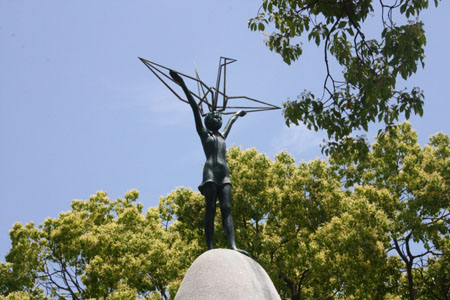 continues
about the consequences of the bomb for the population. It deals with the
many dead and wounded as well as the cancer victims in the years after. At
the end you can watch eye witness testimony by survivors. Obviously they
were only children when it happened. Due to their unimaginable wounds and
the extreme devastation they went to a real living hell. The testimony is
very touching to hear. After the museum we go for lunch near the hotel. In
the afternoon we go and wash our clothes in a laundrette (coin laundry in
Japenglish) across from the hotel. Erik accidentally washes his rail pass he
forgot to take out of his pockets. What remains of it is no more than a few
bits of sorry looking paper. Fortunately the bit with the dates of validity
was sealed with plastic and is still intact and
continues
about the consequences of the bomb for the population. It deals with the
many dead and wounded as well as the cancer victims in the years after. At
the end you can watch eye witness testimony by survivors. Obviously they
were only children when it happened. Due to their unimaginable wounds and
the extreme devastation they went to a real living hell. The testimony is
very touching to hear. After the museum we go for lunch near the hotel. In
the afternoon we go and wash our clothes in a laundrette (coin laundry in
Japenglish) across from the hotel. Erik accidentally washes his rail pass he
forgot to take out of his pockets. What remains of it is no more than a few
bits of sorry looking paper. Fortunately the bit with the dates of validity
was sealed with plastic and is still intact and
perfectly legible. We go to the railway station to ask for a replacement.
The attendant looks at the pass’s remains and says it will not be necessary.
It is good for travel he insists. We urge him to check with his supervisor,
but he too sees no problem. We have to take their word for it… WE head back
to the city by tram. We have dinner at the Korean restaurant
Bokuden, where
the guests are greated by the entire staff in unison. We have to leave our
shoes by the entrance and and along the kitchen. Ordering is bit difficult
as none of the staff speaks even the most basic English and there is no
english menu either. With some help from our language guide book and the
translation app by Google we manage anyway. The food is good.
Weather: warm 28°C/82°F.
Thursday 23 May 2013
We take a regional
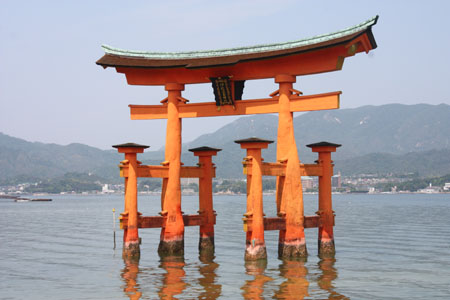 JR
train to Miyajimaguchi. The journey takes no more than 30 minutes. There we
take the JR ferry for a 10 minute crossing to the island of Miyajima. Erik's
damaged Railpass is being accepted without any comment. Miyajima
is a small island off the coast and site for a large and important
Shinto-shrine. On the mountain top is Buddhist sacred place belonging to the
Shingon sect of Kaiku. We start at the Shinto-shrine, the Itsukushima-jinja.
The shrine is on the UNESCO World Heritage List. There has been a shrine
here since the 6th century, but the present buildings are 12th century. In
front of the shrine we see a big Torii (gate) from 1875 standing in the
water. This signals that the entire Island is sacred. At low tide the Torii
is on dry land. When we enter the shrine we notice preparations for a
wedding ceremony. A
JR
train to Miyajimaguchi. The journey takes no more than 30 minutes. There we
take the JR ferry for a 10 minute crossing to the island of Miyajima. Erik's
damaged Railpass is being accepted without any comment. Miyajima
is a small island off the coast and site for a large and important
Shinto-shrine. On the mountain top is Buddhist sacred place belonging to the
Shingon sect of Kaiku. We start at the Shinto-shrine, the Itsukushima-jinja.
The shrine is on the UNESCO World Heritage List. There has been a shrine
here since the 6th century, but the present buildings are 12th century. In
front of the shrine we see a big Torii (gate) from 1875 standing in the
water. This signals that the entire Island is sacred. At low tide the Torii
is on dry land. When we enter the shrine we notice preparations for a
wedding ceremony. A 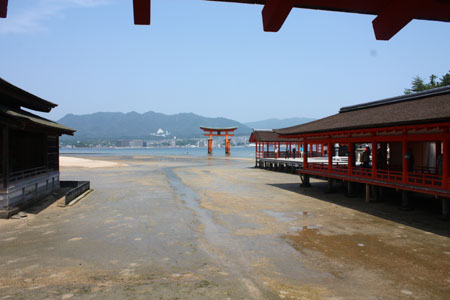 priest
in an orange coloured outfit and a mask perform intricate looking dances to
entertain the gods. Afterwards the guests applaud and the married couple
gets its picture taken against the backdrop of the Torii and the sea. We
walk towards the cable car, that will take us to the lookout point on Mt
Misen. Fortunately we do not have to walk all the way to
the ground station, but can use a free courtesy bus. The cable care
(ropeway) takes us over a forest half way up the mountain. There we have to
change to a different cable car that takes up to the lookout. We have fine
views over the Japanese Inland Sea and the Honshu coastline. From there it
is a 20 minute hike to the temple with the eternal fire, that was lit 1,200
years ago by the monk Kukai – we remember him from our visit to
Koya-san a week before. The track
goes down for quite a bit before it goes steeply upwards
priest
in an orange coloured outfit and a mask perform intricate looking dances to
entertain the gods. Afterwards the guests applaud and the married couple
gets its picture taken against the backdrop of the Torii and the sea. We
walk towards the cable car, that will take us to the lookout point on Mt
Misen. Fortunately we do not have to walk all the way to
the ground station, but can use a free courtesy bus. The cable care
(ropeway) takes us over a forest half way up the mountain. There we have to
change to a different cable car that takes up to the lookout. We have fine
views over the Japanese Inland Sea and the Honshu coastline. From there it
is a 20 minute hike to the temple with the eternal fire, that was lit 1,200
years ago by the monk Kukai – we remember him from our visit to
Koya-san a week before. The track
goes down for quite a bit before it goes steeply upwards
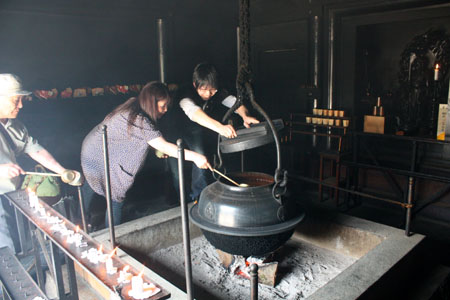 for
about 700 metres. Exhausted I arrive up there. The flame is indeed alight in
the Kiezu-no-Reikadō, heating a kettle. Visitors take some water out of the
kettle and drink it. Opposite of this is the Misen-Hondo, the prayer hall.
From here it is another 10 minutes hike up to the summit at 535 metres above
the sea, but I give it miss. I go back to the lookout to meet Erik. From
there we take the cable cars down to the village. In the village we have
some simple lunch and then on to the ferry to the mainland.
for
about 700 metres. Exhausted I arrive up there. The flame is indeed alight in
the Kiezu-no-Reikadō, heating a kettle. Visitors take some water out of the
kettle and drink it. Opposite of this is the Misen-Hondo, the prayer hall.
From here it is another 10 minutes hike up to the summit at 535 metres above
the sea, but I give it miss. I go back to the lookout to meet Erik. From
there we take the cable cars down to the village. In the village we have
some simple lunch and then on to the ferry to the mainland.
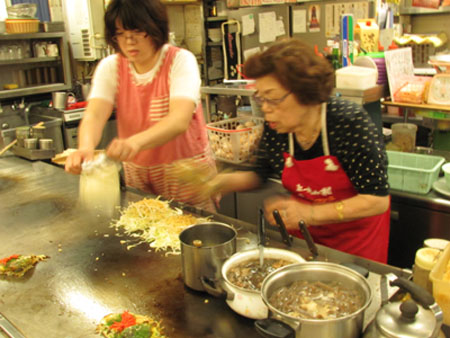 After
a short wait we catch a train to Hiroshima.
After
a short wait we catch a train to Hiroshima.
At night we eat Okonomiyaki in Okonomi-mura, the Okonomiyaki village. This is a building with 28 food stalls where they prepare and serve this Hiroshima dish, just with different ingredients. It is a pancake, topped with a mixture of noodles, cabbage, bean sprouts, pork and finished off with the special Okonomyaki-saus by Sun Foods and fried egg. They prepare on a hot plate and when ready it is shoved towards you and kept hot on the plate. The dish tastes fine and costs little. Not even 5 euros. We drink a cup of coffee before we head back for the hotel.
Weather: warm and sunny 29°C/84°F
|
|
Other Travel | |
| back | Photo-Album Japan | continue |